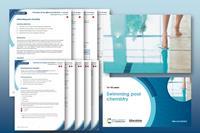Use these synoptic questions to explore structure and bonding, equilibrium, spectrometry and spectroscopy in an interesting context
This resource accompanies the article What am I swimming in? The worksheet originally appeared in the book Chemistry for the gifted and talented.
Learning objectives
- Describe how the water in swimming pools is disinfected.
- Calculate the concentration of various ions present in the water.
- Interpret data obtained from a mass spectrometer.
- Suggest/determine the structure of organic molecules.
Introduction
Chlorine (Cl2) is now rarely added directly to pools in the UK because of the hazards associated with its storage and use. Other chlorinating agents are used instead.
In a typical swimming pool, sodium chlorate(I) is added to disinfect the water. The chlorate(I) ion is the conjugate base of the weak acid HOCl. The equilibrium constant Ka for HOCl = 2.9 x 10-9 at 298 K. Both the chlorate(I) ion and the acid HOCl are involved in the disinfecting.
Some data were obtained from a swimming pool in Taunton, on a particular day in September. The combined concentration of HOCl(aq) was measured as 0.50 parts per million (ppm). The pH was 7.3.
Notes to teachers
This activity is synoptic in nature, with questions on many different aspects of chemistry. It is context driven, looking at a collection of interesting chemistry that can be derived from swimming pools.
The main subject content areas are:
- Structure and bonding
- Equilibrium
- Spectrometry
- Spectroscopy
There are two versions of the student sheet. One is aimed at stretching the most able and the other comes with hints on how to answer the questions, making it accessible to a wider range of students.
The activity comes in two parts and these can be given separately to the students.
- Part 1 can be used at the end of teaching equilibrium or at the end of a course.
- Part 2 should be attempted at the end of a course.
The accompanying presentation should be used to set the scene and stimulate discussion.
Curriculum links
- Equilibria (Kc, Ksp, Ka buffers, Le Chatelier’s principle) and entropy (solvent effects).
- Mass spectra, oxidation numbers, curly arrow mechanisms, nuclear magnetic resonance (NMR) spectroscopy, delocalisation, tautomerism and relative molecular mass calculations.
Please note that most A level courses and the Scottish Advanced Highers do not require students to carry out Ksp calculations. However, information included within the accompanying presentation should allow students to access the questions.
Tautomerism is beyond the scope of most post-16 specifications, however enough information is included in the question to allow students to answer.
Prior knowledge
Kc, pH, Le Chatelier’s principle, buffers, spectra, NMR and curly arrows.
More resources
- Explore the halogens, their salts and their relation to swimming with this Chemistry and Sport resource.
- Find out why the properties of water are vital to the sports men and women who compete in, on, and around water with this Water sports and solutions resource.
- Discover how Katty, a Higher Apprentice and laboratory analyst, monitors the levels of organic materials in drinking and wastewater.
Downloads
Swimming pool chemistry - student sheet
Editable handout | Word, Size 0.52 mbSwimming pool chemistry - student support sheet
Editable handout | Word, Size 0.52 mbSwimming pool chemistry - teacher notes
Editable handout | Word, Size 0.62 mbSwimming Pool chemistry - presentation
Presentation | PowerPoint, Size 21.71 mbSwimming pool chemistry - student sheet
Handout | PDF, Size 0.29 mbSwimming pool chemistry - student support sheet
Handout | PDF, Size 0.32 mbSwimming pool chemistry - teacher notes
Handout | PDF, Size 0.5 mbSwimming Pool chemistry - presentation
Presentation | PDF, Size 1.48 mb
Additional information
This resource originally appeared in the book Chemistry for the gifted and talented by Tim Jolliff. The resource was reviewed and additional content added in May 2022 by Dorothy Warren.



















No comments yet